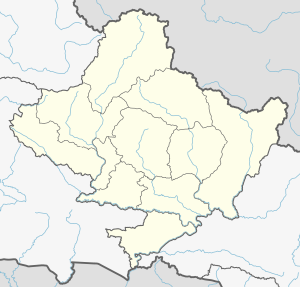This article needs additional citations for verification. (January 2016) |
Dhorpatan is a municipality in Nepal's Baglung District, 3,900 meters elevation in an east–west valley south of the Dhaulagiri mountain range in the Himalayas.[1] It is the headquarters of Dhorpatan Hunting Reserve. There is a small community of indigenous Kham Magar people as well as Tibetan refugees.
Dhorpatan | |
|---|---|
| Coordinates: 28°29′N 83°04′E / 28.483°N 83.067°E | |
| Country | |
| Province | Gandaki Province |
| District | Baglung District |
| Government | |
| • Mayor | Dev Kumar Nepali |
| • Deputy Mayor | Karmati Magar |
| Area | |
| • Total | 222.85 km2 (86.04 sq mi) |
| Population | |
| • Total | 26,215 |
| • Density | 120/km2 (300/sq mi) |
| • Religions | Hindu Buddhism |
| Time zone | UTC+5:45 (NST) |
| Website | dhorpatanmun.gov.np |
The enclosing valley is drained to the west by the Uttar Ganga, tributary of the Bheri River, which in turn joins the Karnali River. The east–west orientation of Dhorpatan Valley offers an easy—by himalayan standards—route between the Karnali basin of western Nepal and the Gandaki River basin in the center, over a 3,400-meter pass on the watershed 18 km east of the town. This was an historic migration route for Khas people eastward in the late Middle Ages. Ensuing political evolution led to the unification of the Kingdom of Nepal from loose confederations in the Karnali and Gandaki' regions and from other confederations further east.
A seasonal STOL airstrip 1 km to the west serves the valley. Dhorpatan can also be reached from Baglung via Burtibang by bus or jeep, and by jeep from Beni via Myagdi Khola. Dolpa is a few days trek to the north around the western Dhaulagiri range. There are a few homestay lodges serving basic food, tea, coffee and milk. Cottages are available for hunters holding entry and hunting permits. During the summer months large herds of livestock are taken northwards from the Rapti Zone by Kham Magar people for grazing in surrounding pastureland. Animal husbandry, handicrafts and some tourism are the key economic activities of the people in the region.
Demographics
editAt the time of the 2011 Nepal census, Dhorpatan Municipality had a population of 26,438. of these, 95.6% spoke Nepali, 2.0% Magar, 1.5% Chantyal, 0.3% Kham, 0.1% Maithili, 0.1% Thakali and 0.1% other languages as their first language.[2]
In terms of ethnicity/caste, 39.3% were Kami, 22.6% Magar, 16.9% Chhantyal, 8.9% Hill Brahmin, 3.0% Damai/Dholi, 2.5% Chhantyal, 2.0% Kumal, 1.1% Kayastha, 0.5% Sarki, 0.5% Thakali, 0.4% Musalman, 0.4% Sanyasi/Dasnami, 0.3% other Dalit, 0.3% Gurung, 0.3% Newar, 0.2% Gharti/Bhujel, 0.2% Thakuri, 0.1% Tamang, 0.1% other Terai and 0.2% others.[3]
In terms of religion, 91.1% were Hindu, 5.6% Buddhist, 1.0% Christian, 0.7% Prakriti, 0.4% Muslim and 1.1% others.[4]
In terms of literacy, 63.0% could read and write, 2.9% could only read and 33.9% could neither read nor write.[5]
References
edit- ^ Millard, C. (2007). Democracy and Dissent in Nepal: An Overview and some Perceptions in the Valley of Dhorpatan. Pages 281–304 in Gellner, D. (ed.) Resistance and the State: Nepalese Experiences. Berghahn Books.
- ^ NepalMap Language
- ^ NepalMap Caste
- ^ NepalMap Religion
- ^ NepalMap Literacy

